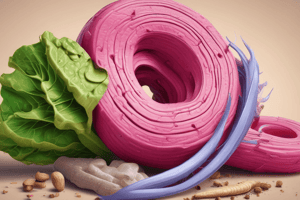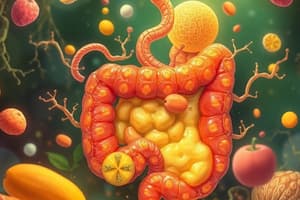Podcast
Questions and Answers
What is a key factor determining how carbohydrates affect the gut microbiota?
What is a key factor determining how carbohydrates affect the gut microbiota?
- The speed at which the carbohydrate is digested in the small intestine.
- The presence of sweeteners such as polyols.
- Whether it can reach the colon without digestion. (correct)
- The total quantity of carbohydrates consumed daily.
Which of the following is NOT associated with low microbial diversity in the gut?
Which of the following is NOT associated with low microbial diversity in the gut?
- Obesity
- Increased levels of Lactobacillus (correct)
- Psoriatic arthritis
- Inflammatory bowel disease
What role does fermentation play in the context of dietary fiber and the gut microbiota?
What role does fermentation play in the context of dietary fiber and the gut microbiota?
- It reduces the production of SCFAs.
- It leads to increased absorption in the small intestine.
- It is a minor function of the gut microbiota.
- It is a main source for SCFAs. (correct)
How does a high sugar diet generally affect the gut microbiota?
How does a high sugar diet generally affect the gut microbiota?
What are dietary fibers primarily resistant to?
What are dietary fibers primarily resistant to?
Which of the following is NOT a benefit associated with dietary fibre intake?
Which of the following is NOT a benefit associated with dietary fibre intake?
What is the primary role of butyrate within the colon?
What is the primary role of butyrate within the colon?
Which short-chain fatty acid (SCFA) is most abundant?
Which short-chain fatty acid (SCFA) is most abundant?
Which of the statements best describes the relationship between dietary fat intake and cardiovascular disease (CVD)?
Which of the statements best describes the relationship between dietary fat intake and cardiovascular disease (CVD)?
What is one of the main functions of propionate?
What is one of the main functions of propionate?
Higher production of SCFAs is associated with?
Higher production of SCFAs is associated with?
Besides being an energy source for colonocytes, what additional function does butyrate have?
Besides being an energy source for colonocytes, what additional function does butyrate have?
What is one of the roles of acetate?
What is one of the roles of acetate?
What is the primary focus of recent dietary guidelines regarding fat intake?
What is the primary focus of recent dietary guidelines regarding fat intake?
Which of the following gut bacteria genera is associated with the consumption of unsaturated fats, based on animal studies?
Which of the following gut bacteria genera is associated with the consumption of unsaturated fats, based on animal studies?
Within the context of gut microbiota studies, diets were found to cluster into which of the following subgroups at the phylum level?
Within the context of gut microbiota studies, diets were found to cluster into which of the following subgroups at the phylum level?
What effect do saturated fats have on the gut microbiome?
What effect do saturated fats have on the gut microbiome?
In a study on hamsters, which phylum showed the largest differences in gut microbiota diversity when comparing soy-fed hamsters to those fed milk protein isolate?
In a study on hamsters, which phylum showed the largest differences in gut microbiota diversity when comparing soy-fed hamsters to those fed milk protein isolate?
What is a potential consequence, according to the text, of a diet high in saturated fat?
What is a potential consequence, according to the text, of a diet high in saturated fat?
Which of the following is NOT a suggested strategy for regulating gut microbiota and inflammation?
Which of the following is NOT a suggested strategy for regulating gut microbiota and inflammation?
Which compounds found in processed meat are associated with an increased risk of colorectal cancer?
Which compounds found in processed meat are associated with an increased risk of colorectal cancer?
What is the primary function of bile acids (BAs) mentioned in the text?
What is the primary function of bile acids (BAs) mentioned in the text?
Lactic-acid-producing bacteria like Lactobacillus may offer protection against DNA damage and neoplasia by doing what?
Lactic-acid-producing bacteria like Lactobacillus may offer protection against DNA damage and neoplasia by doing what?
What is a general, but not always consistant, outcome associated with high-protein diets?
What is a general, but not always consistant, outcome associated with high-protein diets?
What implication does the text present about the transfer of gut microbiome disruption due to fat intake?
What implication does the text present about the transfer of gut microbiome disruption due to fat intake?
What type of study is specifically mentioned as being needed to resolve conflicting reports?
What type of study is specifically mentioned as being needed to resolve conflicting reports?
What is the primary role of bile acids (BAs) regarding dietary fats?
What is the primary role of bile acids (BAs) regarding dietary fats?
How do gut microbiota influence bile acid (BA) metabolism?
How do gut microbiota influence bile acid (BA) metabolism?
What is the mechanism by which bile acids (BAs) can reduce blood cholesterol levels?
What is the mechanism by which bile acids (BAs) can reduce blood cholesterol levels?
Which of the following best describes the effect of bacterial metabolism of L-carnitine?
Which of the following best describes the effect of bacterial metabolism of L-carnitine?
Which of the following is true regarding the production of branched-chain amino acids (BCAAs) in the body?
Which of the following is true regarding the production of branched-chain amino acids (BCAAs) in the body?
What is the link between Parabacteroides merdae and the metabolism of BCAAs?
What is the link between Parabacteroides merdae and the metabolism of BCAAs?
What are the key products of aromatic amino acid metabolism by gut microbiota, and what effects do they have?
What are the key products of aromatic amino acid metabolism by gut microbiota, and what effects do they have?
What is the end product of dietary tryptophan metabolism by gut microbiota, and how is it further metabolized?
What is the end product of dietary tryptophan metabolism by gut microbiota, and how is it further metabolized?
Which of the following artificial sweeteners has been shown to disrupt the balance of colon microbiota?
Which of the following artificial sweeteners has been shown to disrupt the balance of colon microbiota?
According to animal studies, which effect has been linked to the consumption of food emulsifiers such as carboxymethylcellulose and polysorbate-80?
According to animal studies, which effect has been linked to the consumption of food emulsifiers such as carboxymethylcellulose and polysorbate-80?
What is a potential negative effect of a gluten-free diet in individuals without gluten intolerance or coeliac disease?
What is a potential negative effect of a gluten-free diet in individuals without gluten intolerance or coeliac disease?
Which type of diet has been shown to reduce the symptoms of irritable bowel syndrome (IBS)?
Which type of diet has been shown to reduce the symptoms of irritable bowel syndrome (IBS)?
Which of the following dietary components is highlighted as an important nutrient for a healthy microbiome?
Which of the following dietary components is highlighted as an important nutrient for a healthy microbiome?
What is a key consideration when applying restrictive diets for improving gut health?
What is a key consideration when applying restrictive diets for improving gut health?
What is a general recommendation for healthy eating patterns to support a healthy gut microbiota?
What is a general recommendation for healthy eating patterns to support a healthy gut microbiota?
What should an 'optimal diet' take into account?
What should an 'optimal diet' take into account?
Flashcards
Gut Microbiota
Gut Microbiota
The mix of microorganisms living in the gut. It's vital for digestion and overall health.
Microbial Diversity
Microbial Diversity
A sign of a healthy gut. Having a wide variety of microbe species is beneficial.
Nutritional Modulation of the Gut Microbiome
Nutritional Modulation of the Gut Microbiome
The study of how diet changes the composition and function of the gut microbiota.
Fermentable Carbohydrates
Fermentable Carbohydrates
Signup and view all the flashcards
SCFAs (Short-Chain Fatty Acids)
SCFAs (Short-Chain Fatty Acids)
Signup and view all the flashcards
Fermentable Fiber
Fermentable Fiber
Signup and view all the flashcards
Butyrate
Butyrate
Signup and view all the flashcards
Propionate
Propionate
Signup and view all the flashcards
Acetate
Acetate
Signup and view all the flashcards
Intestinal Barrier Function
Intestinal Barrier Function
Signup and view all the flashcards
Digestion
Digestion
Signup and view all the flashcards
Impact of high protein diets on the gut
Impact of high protein diets on the gut
Signup and view all the flashcards
Meat vs. Non-meat diets and gut bacteria
Meat vs. Non-meat diets and gut bacteria
Signup and view all the flashcards
Lactobacillus and protection against meat-associated cancer risk
Lactobacillus and protection against meat-associated cancer risk
Signup and view all the flashcards
Processed meat and colorectal cancer
Processed meat and colorectal cancer
Signup and view all the flashcards
Gut microbiome and meat consumption: More research needed
Gut microbiome and meat consumption: More research needed
Signup and view all the flashcards
Saturated fat's effect on gut bacteria
Saturated fat's effect on gut bacteria
Signup and view all the flashcards
Unsaturated fat's effect on gut bacteria
Unsaturated fat's effect on gut bacteria
Signup and view all the flashcards
Diet's impact on gut bacteria inheritance
Diet's impact on gut bacteria inheritance
Signup and view all the flashcards
What are bile acids?
What are bile acids?
Signup and view all the flashcards
Effect of high LPS levels
Effect of high LPS levels
Signup and view all the flashcards
What is Lipopolysaccharide (LPS)?
What is Lipopolysaccharide (LPS)?
Signup and view all the flashcards
Impact on gut permeability
Impact on gut permeability
Signup and view all the flashcards
Long-term effects of diet on the gut microbiome
Long-term effects of diet on the gut microbiome
Signup and view all the flashcards
Artificial sweeteners and gut health
Artificial sweeteners and gut health
Signup and view all the flashcards
Emulsifiers and gut health
Emulsifiers and gut health
Signup and view all the flashcards
Vegan/Vegetarian diets and gut health
Vegan/Vegetarian diets and gut health
Signup and view all the flashcards
Raw food diets and gut health
Raw food diets and gut health
Signup and view all the flashcards
Gluten-free diets and gut health
Gluten-free diets and gut health
Signup and view all the flashcards
FODMAP diets and gut health
FODMAP diets and gut health
Signup and view all the flashcards
Long-term dietary habits and gut health
Long-term dietary habits and gut health
Signup and view all the flashcards
Personalized gut health
Personalized gut health
Signup and view all the flashcards
What are bile acids (BAs) and what are their roles?
What are bile acids (BAs) and what are their roles?
Signup and view all the flashcards
How do gut microbes interact with bile acids (BAs)?
How do gut microbes interact with bile acids (BAs)?
Signup and view all the flashcards
How do gut microbes influence cholesterol levels?
How do gut microbes influence cholesterol levels?
Signup and view all the flashcards
What is TMAO and what produces it?
What is TMAO and what produces it?
Signup and view all the flashcards
What are the health risks associated with high TMAO levels?
What are the health risks associated with high TMAO levels?
Signup and view all the flashcards
Which specific bacteria play a role in producing TMAO?
Which specific bacteria play a role in producing TMAO?
Signup and view all the flashcards
What are BCAAs and how are they involved in gut health?
What are BCAAs and how are they involved in gut health?
Signup and view all the flashcards
What happens to aromatic amino acids within the gut?
What happens to aromatic amino acids within the gut?
Signup and view all the flashcards
Study Notes
Nutritional Modulation of the Gut Microbiome
- The gut microbiome is influenced by diet and plays a vital role in metabolic health and longevity.
- Diet modulates the composition and function of the gut microbiota rapidly in response to dietary changes.
- Long-term dietary patterns determine the gut microbiota composition.
- Different people respond differently to dietary changes.
Glucose Metabolism
- Resistant starch and dietary fiber influence glucose metabolism.
- The TCA cycle, a key metabolic pathway, is affected.
- Short-chain fatty acids (SCFAs) play a role in glucose metabolism, influencing hormones.
- GPR41, GPR43, GPR109A, and Olfr78 are receptors involved in the response to SCFAs.
Lipid Metabolism
- Lipid metabolism is affected by factors such as dietary choline and carnitine and the production of TMAO.
- TMAO is a metabolite associated with cardiovascular disease.
- Bile acids influence lipid digestion and absorption.
Protein Metabolism
- Undigested protein and amino acids can reach the colon and be fermented, influencing gut health.
- The branched-chain amino acids (BCAAs) play a role in protein metabolism and are affected by gut microbiota.
- BCAAs can influence insulin resistance.
- TMAO is formed from choline, betaine and L-carnitine and is associated with various health markers that affect thrombosis and cardiovascular diseases.
Dysbiosis and Disease
- Dysbiosis, an imbalance in the gut microbiome, can lead to various diseases.
- External influences such as diet, prebiotics, probiotics, antibiotic usage, illness, lifestyle and living environment influence dysbiosis.
- Internal host factors like Age, genetics, physiologic processes and structure/physiology of the gut influence dysbiosis and disease.
Microbial Diversity
- Low microbial diversity is associated with obesity, inflammatory bowel disease, psoriatic arthritis, diabetes, atopic eczema, and celiac disease.
- High microbial diversity is considered an indicator of a healthy gut.
Effects of Dietary Components
- The effects of carbohydrates on gut microbiota depend on their chemical structure and ability to reach the colon for fermentation.
- Dietary fibers are fermentable and a major source of SCFAs, influenced by the gut microbiota.
- Dietary fiber improves glucose tolerance and insulin resistance; reduces weight gain and improves intestinal integrity and is positively associated with the increased SCFA-producing microbiota.
- High sugar diets promote gut microbiota dysbiosis.
Short-Chain Fatty Acids (SCFAs)
- SCFAs are important energy sources for colonocytes and influence cell function and homeostasis.
- Butyrate is a primary SCFA associated with colon cell functions, such as apoptosis in cancer cells and oxygen balance; it is also anti-inflammatory.
- Propionate plays a role in glucose homeostasis and gluconeogenesis.
- Acetate is vital for microbial growth, cholesterol metabolism and lipogenesis.
- Higher SCFA production correlates with reduced weight gain and insulin resistance.
Interactions between Diet and Gut Microbiota
- Microbial diversity and dietary fiber influence SCFA production, which further impacts health outcomes.
- Low diversity limits the access to complex carbohydrates, thus reducing SCFA production.
- The diet-gut microbiota interaction dictates the production of SCFAs.
Fat
- High dietary fat intake has not been shown to be definitively harmful (except possibly concerning trans fat).
- Recent studies encourage optimizing fat types in the diet rather than reducing total fat intake.
- Saturated fat can increase LPS-expressing bacteria which impacts inflammation and increase in blood pressure levels, adiposity and insulin insensitivity.
- Beneficial fats do not cause adverse effects.
- The effects of fat on the gut microbiome can be passed on to offspring.
Bile Acid Metabolism
- Bile acids are synthesized from cholesterol in the liver and stored in the gallbladder for digestion.
- Bile acids facilitate fat digestion and act as important factors in various biological processes as important for liver functions and metabolism.
- Gut microbiota influence bile acid transformation and metabolism.
- BAs have bacteriostatic and antimicrobial properties.
Protein
- High protein intake can cause weight loss, potentially associated with TMA, a metabolite associated with cardiovascular risk factors.
- Red and processed meat are often linked to elevated levels of trimethylamine N-oxide (TMAO).
- Specific protein sources, such as meat, can lead to increased levels of harmful metabolites associated with an increased risk for cardiovascular disease.
BCAAs
- BCAAs are essential amino acids, mostly obtained from animal products.
- Intakes can be associated with insulin resistance.
Food Additives
- Emulsifiers, such as carboxymethylcellulose and polysorbate, can cause dysbiosis, inflammation, and metabolic syndromes.
Artificial Sweeteners
- Artificial sweeteners (sucralose, aspartame, and saccharin) can disrupt gut microbiome diversity and balance and can induce glucose intolerance in some cases.
Restrictive Diets
- Vegan and vegetarian diets may promote a diverse ecosystem of beneficial microbes.
- Raw food diets can increase infection risk
- Gluten-free diets may be beneficial for people with gluten sensitivity.
- FODMAP restriction may ease irritable bowel syndrome symptoms.
Poor Quality vs. Healthy Diet
- A poor quality diet often includes animal-derived proteins, saturated fats, refined grains, sugar, salt, alcohol, and corn-derived fructose; this is contrasted by the healthy diet emphasizing fruits, vegetables, fibers, plant-derived protein, unsaturated fats, and healthy fatty acids.
- Poor quality diets are associated with reduced microbial diversity, and increased pathogen infections, inflammation, and intestinal permeability.
- Healthy diets have high microbial diversity, colonization resistance, healthy gut barrier function.
Long-Term Dietary Habits
- Long-term dietary habits affect the quality of the gut microbiota.
- Beneficial eating patterns are rich in dietary fiber, healthy fats, and plant-derived proteins.
- Diets are important to be tailored to the individual based on needs and taking the gut microbiota into consideration.
Take Home Messages
- Quality and quantity of dietary components are important
- Balance is crucial
- Dietary fiber is vital
- Restrictive diets need careful consideration
- Individualized diets, considering gut microbiota, are optimal.
Studying That Suits You
Use AI to generate personalized quizzes and flashcards to suit your learning preferences.




